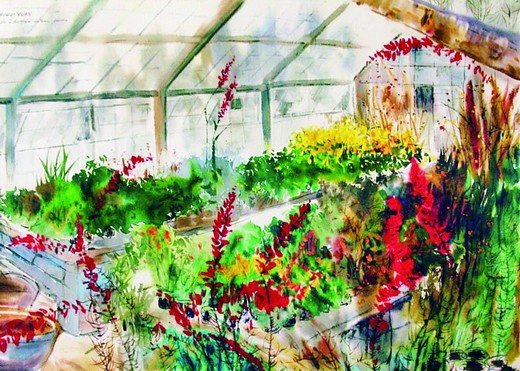(Ecns.cn)--Without any opening ceremony or speech, a folk art exhibition held by 12 Chinese painters quietly opened at the Children's Palace in Huangpu District, Shanghai on January 27, 1979, the day before the Spring Festival that year.
Though there were no extravagant pictures of abstractionism or traditional Chinese paintings, the exhibition, swarming with pictures of flowers, still plants, and characters of the Peking Opera, ignited a new development era for folk art exhibitions in China.
This exhibition was the first folk art exhibition held after the foundation of the People's Republic of China in 1949 and a new form of display after the restrained period of the Cultural Revolution (1966 to 1976).
"The exhibition was a result of open talks and drinks," recalled Chen Juyuan, one of the 12 painters, over 30 years after of their exhibition. "I and some other painters, like Shen Tianwan and Xu Siji, used to drink together at Shen's home, but now we seldom have the time," said Chen in an interview with China Newsweek.
Over 30 years have passed. Some of the painters have already died and some have moved to foreign countries, but when talking about the exhibition, these painters who are now seniors, cannot hold their emotions in.
An idea after a drink
"During the Cultural Revolution, people were always in a frightened state, for maybe just one painting that dissatisfied government officials could bring the painter to jail," said Chen. "At that time, we were very depressed."
In 1978, Chen worked as a garden designer at the Shanghai Botanical Garden, which was a job he thought could bring him closer to art and painting, while his friend Shen Tianwan who used to be an owner of a private painting studio was a toy designer at that time.
One day, they went to see an exhibition at the Shanghai History Museum on calligraphy from the Song Dynasty to the Qing Dynasty. For quite a long time, paintings exhibited to the public illustrated themes about the Chinese Communist Party and the central government.
The stylish calligraphy by the ancient people brought excitement to the two artists, and they talked and drank with each other at Shen's home, expressing their ideas on art and the future for a whole night.
During the restrained ten years of the Cultural Revolution, Shen's home was like a base for artists. Most people living around him were their relatives and close friends, so they did not have to worry too much about whether the content of their talk would be leaked out, said Shen's wife.
That night they came up with the idea to hold their own exhibition for the first time. "I've been waiting for decades and I wonder when we will display our own work," said Shen, who was then nearly 50, to Chen, 40, who was confident that they would have that day soon.
A few days later, when having dinner with two other friends, Xu Siji and Han Boyou, the two spoke out their idea to open an art exhibition, and not surprisingly, Xu and Han supported them and expressed their hope of joining them.
"Though the Cultural Revolution was over, the idea was still a little bit bold," recalled Xu. At that time, there were no folk art exhibitions and all the exhibitions held needed to gain approval from the relative cultural department.
"There needed to be someone coming out to lead a new trend. What we wanted to display had nothing to do with politics. They were only paintings of flowers and plants," said Shen. "I thought that we had a right to bring new things to the public who had suffered from too many sad things," added Shen.
Though worried, the four artists began taking action to make their dream come true.


















